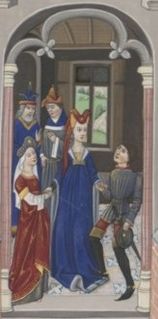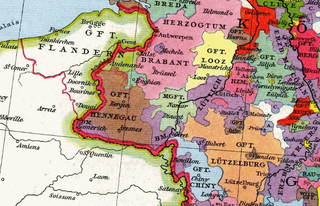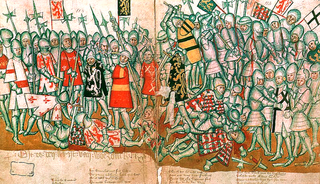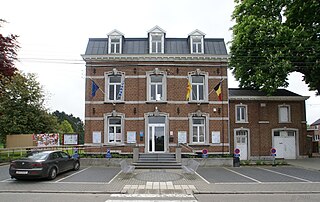
Chiny is a Walloon municipality of Belgium located in the province of Luxembourg. On 1 January 2007 the municipality, which covers 113.69 km2 (43.90 sq mi), had 5,021 inhabitants, giving a population density of 44.2 inhabitants per km².

Louis II was count of Loon between the end of the 12th century to 1218. He was the son of Gérard II, Count of Looz, and Adelaide of Gelderland, daughter of Henry I, Count of Guelders, and Agnes of Arnstein, daughter of Louis III of Arnstein. He also claimed to be the legitimate Count of Holland during the Loon War (1203–1206).
Giselbert van Loon is probably the first, and certainly the first definitely known count of the County of Loon, a territory which to roughly correspond to the modern Belgian province of Limburg, and generations later became a part of the Prince-bishopric of Liège. Very little is known about him except that he had two brothers, one of whom, Bishop Balderic II of Liège, is much better attested in historical records.

Arnold IV of Loon (Looz), was Count of Loon from 1227 to 1273 and Count of Chiny from 1228 to 1268. He was the son of Gérard III, Count of Rieneck and Cunegonde von Zimmern.

Louis I, Count of Loon (Looz) was the Count of Loon, which he inherited from his father. He ruled from approximately 1139 until his death.
Louis V (1235-1299), Count of Chiny (1268-1299), the youngest son of Arnold IV, Count of Looz and Chiny, and Jeanne, Countess of Chiny. He became Count of Chiny in 1268 when his parents entrusted him with the county before their death.
Louis IV, Count of Looz (1323-1336) and Count of Chiny (1313-1336), son of Arnold V, Count of Looz and Chiny, and Marguerite Vianden.
Thierry de Heinsberg , Count of Looz and Count of Chiny (1336-1361), son of Godefroy II, Lord of Heinsberg, son of Dietrich, Lord of Heinsberg, and Jeanne de Louvaine, and Matilda, daughter of Arnold V, Count of Looz and Chiny, and Marguerite Vianden.
Godfrey de Heinsberg, Lord of Daelenbroeck, Count of Looz and Count of Chiny (1361-1362), son of John of Heinsberg, Lord of Daelenbroeck, son of Arnold V, Count of Looz and Chiny, and Catherine de Vroon.
Arnold VI de Rumigny, Count of Looz and Count of Chiny (1362–1364), son of William of Oreye, Lord of Rumigny, and Jeanne de Looz, daughter of Arnold V, Count of Loon and Chiny, and, Marguerite Vianden, Lady of Perwez and Grimbergen.
Count Emmo or Emmon is one of the first known Counts of Loon. Before him one more count is known with confidence, Giselbert of Loon, but it is not certain that Giselbert was his father. Verhelst for example has proposed that he was his uncle, and that Giselbert's brother Count Arnulf was father of Emmo and also a count of Loon.
Arnold I, Count of Looz (Loon), son of Emmo, Count of Loon, and Suanhildis, daughter of Dirk III, Count of Holland, and his wife Othelandis.
Gérard "I" is a wrongly proposed Count of Loon (Dutch), or Looz (French), in what is now Belgian Limburg, who was supposedly mentioned in an 1101 charter of Emperor Henry IV concerning the return of the town of Andenne by Albert III, Count of Namur. There is general consensus that he did not exist.
Arnold II, Count of Looz, son of Arnold I, Count of Looz, and Agnes von Mainz, daughter of Gerhard I, Count of Rieneck, and Helwig von Bliescastel. He is distinguished from his father of the same name by historians who note records for counts named Arnold or Arnulf between 1179 and 1141. The first Arnold must have died between 1125 when Count Arnold appears in a record with his son also named Arnold, and 1135, when a new Count Arnold appears with his own son and successor Louis.
Gérard , Count of Loon (1171–1191), was son and successor of Louis I, Count of Looz, and Agnes of Metz. Because of a widespread misunderstanding concerning a document from 1101, some generations earlier, he is often wrongly referred to as the second Gerard in this dynasty.
Henry, Count of Looz and Count of Duras, son of Gérard II, Count of Looz, and Adelaide of Gelderland, daughter of Henry I, Count of Guelders, and Agnes of Arnstein, daughter of Louis III of Arnstein.
John II ,, Lord of Jülich, Heinsberg and Löwenberg, son of Godfrey de Heinsberg, Count of Looz, and Philippa of Jülich, daughter of William V, Duke of Jülich, and Joanna of Hainaut. Although John was the first son of Godfrey, he did not inherit the countship of Looz, the title instead going to Arnold of Rumingy.







